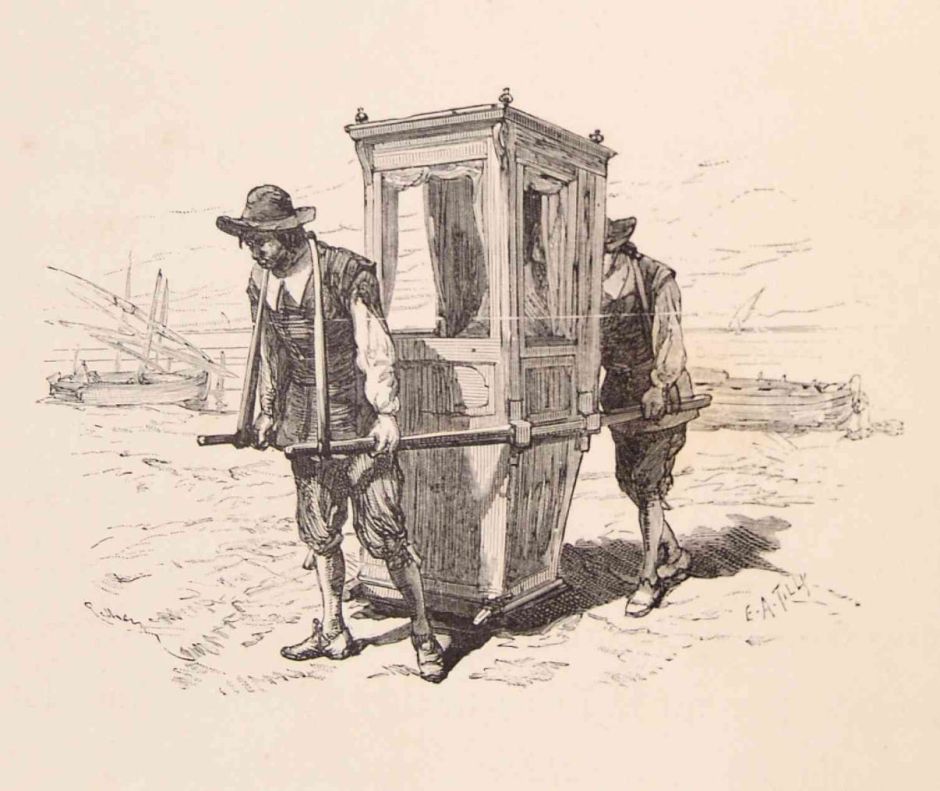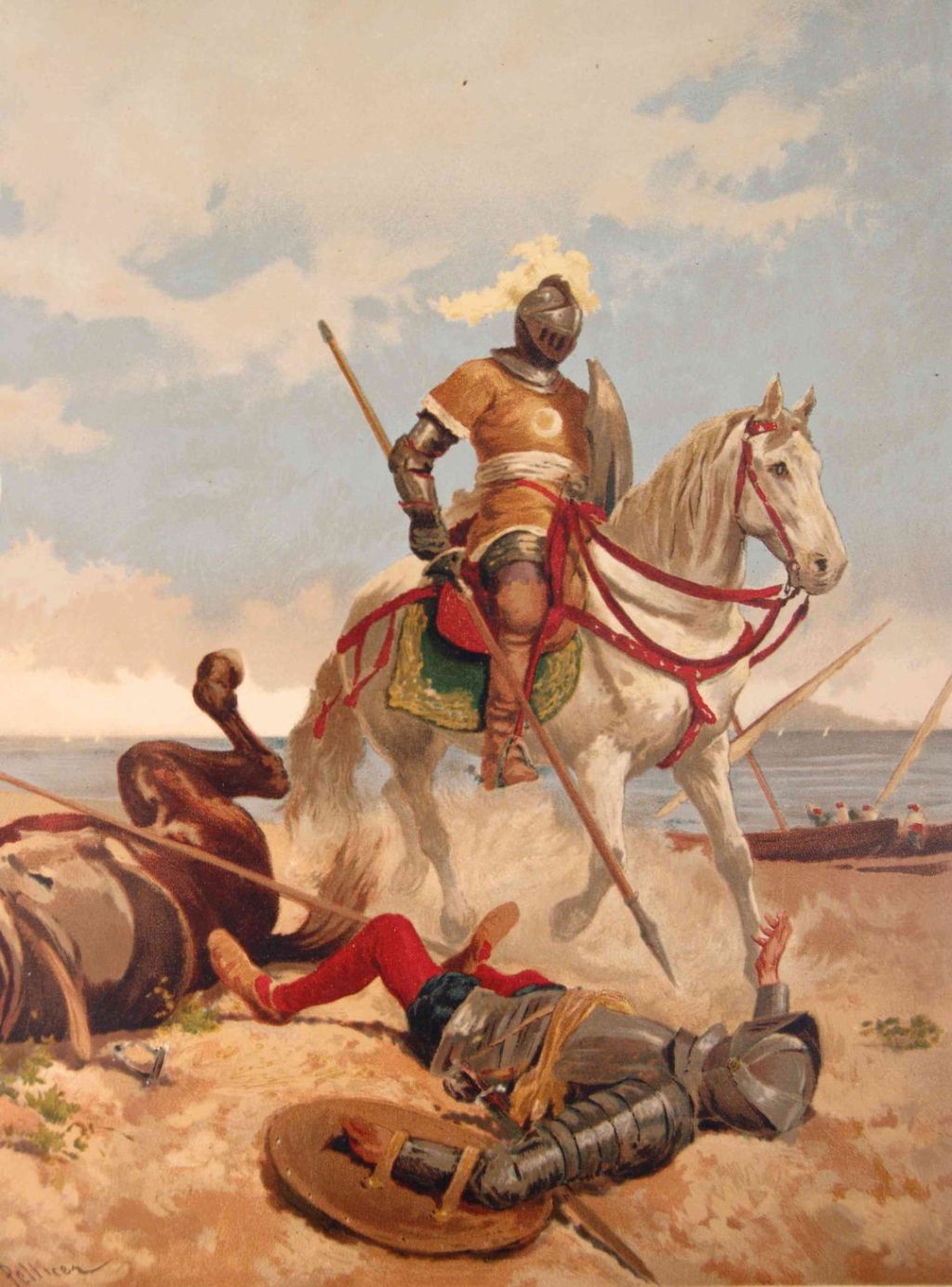In the previous episode, Don Quixote and Sancho Panza had been welcomed into the home of Don Antonio in Barcelona. After the knight and his squire had entertained their host’s friends at lunch, Don Antonio took Don Quixote into a room and showed him an enchanted bust which he claimed gave a truthful answer to any question put to it, except on that day of the week. That night Don Quixote danced at a ball thrown by Don Antonio’s wife, until he was exhausted. The next day they went to ask questions of the enchanted bust, which it answered skilfully while avoiding commitment. That impressed Don Quixote but not his squire. Although the pair never discovered the truth, the bust was just an elaborate deception. Another morning the pair visited a printing-house, where the knight condemned copies of the second part of Don Quixote as being fit only for burning.
That afternoon, Don Antonio took the pair and two of his friends to visit the galleys moored off the beach. The commodore of the vessels was delighted to show them off, and as the party set foot on the beach a pinnace was launched to collect them and take them across the short stretch of sea. When Don Quixote boarded the galley, he was honoured by the firing of cannon and the galley-slaves shouting in unison. The commodore took them to the poop for them to watch its crew, who first stripped to the waist then raised the awning.

One of the crew seized Sancho and he was rolled along in the air on the arms of all the slaves on that side of the galley, and back down the other side to be dropped on the poop. Next the slaves lowered the awning and lowered the lateen-yard to the bottom of the mast, making a din that plainly scared Sancho. The yard was raised again, and the galley weighed anchor as the slaves rowed it out to sea with the other three galleys alongside.

A castle ashore signalled to the galleys that there was an unidentified brigantine to the west, so the commodore ordered two of the galleys to head out to sea, while his flagship and another would keep inshore to prevent it from escaping. When they drew near, the smaller ship tried to make a run for it, but was easily outpaced by the galleys and surrendered.
As they galleys closed in on the brigantine, two drunken Turks on board opened fire and killed two of the soldiers on the forecastle of the galley. The brigantine then tried to escape, but was brought to a halt by the flagship, which took its company prisoner. With the captured vessel in tow, the four galleys returned to the beach at Barcelona, where the Viceroy of Catalina welcomed them. While the flagship lowered its pinnace to bring the Viceroy on board, the lateen-yard was also lowered for the crew of the brigantine to be hanged from it.
The commodore had just asked the captain of the brigantine why their crew had opened fire, when he had to go and welcome the Viceroy aboard. The latter then discovered that the captain was a Christian woman, whom he granted permission to explain herself before she was hanged from the yard alongside her crew.
She told them that she was born of Moriscan parents, but a true Catholic herself. The oldest son of a local lord fell in love with her, and when she was to be sent to Algiers in exile, he buried treasure for her and went in search of somewhere they could live together in safety. The King of Algiers came to hear of her great beauty, so he summoned her and asked after her wealth. However, the king had heard of the presence of her lover, and summoned him. The woman sensed danger, and presented her lover as a woman. This backfired, as the king decided to keep her lover as a present for the Grand Turk, and removed him immediately.
She explained that the king then arranged for her to be returned to Spain in the brigantine, and that the two Turks who had killed the soldiers had disregarded their orders. She finally requested that she be allowed to die as a Christian, and broke down in tears.
The Viceroy was moved by her story, took away the rope from around her neck and unbound her hands. As he was doing that, an old man who had boarded the ship with the Viceroy threw himself at the woman’s feet and declared himself to be her father, who had recovered the treasure that had been buried for the young woman. This was the same Moriscan man who was known to Sancho Panza, who confirmed his story.
The crew of the brigantine were freed as a result, leaving the problem of recovering the woman’s lover, whose life was still in danger in Algiers. They agreed plans for a small crew to attempt the man’s rescue in return for some jewels. With that the Viceroy returned ashore, and Don Antonio took the Moriscan woman and her father home with him, together with Don Quixote and Sancho Panza.
Don Antonio, Don Quixote and Sancho Panza discussed the plan for the rescue mission, and proposed that, should it fail, they would send Don Quixote. The mission set off a couple of days later, and one morning afterwards Don Quixote was riding on the beach in full armour when he was hailed there by another knight on his charger.
This was the Knight of the White Moon, who informed him that he had come to fight him and force him to admit that his lady was more fair than the lady Dulcinea. White Moon told Don Quixote that the only satisfaction he would demand was that the knight returned to his village and remained there in peace for the next year. The bewildered Don Quixote accepted his challenge.
The Viceroy heard of this, and rode out immediately to the beach where the two knights were about to join combat. He planted himself between them and asked the cause of their dispute. When they told the Viceroy, he rode over to Don Antonio to ask if this were some hoax he was playing, but Don Antonio had no knowledge of this Knight of the White Moon. The Viceroy decided to let the duel continue.

The two knights turned their horses round and started their charge almost immediately. Although the Knight of the White Moon didn’t touch Don Quixote with his lance, the force of his charge knocked both Don Quixote and Rocinante to the ground. With the knight still sprawled on the ground, White Moon held his lance to his opponent’s closed visor and demanded satisfaction.

Don Quixote feebly swore continuing allegiance to the Lady Dulcinea, and told White Moon to drive his lance home and kill him. But his opponent refused, insisting only that Don Quixote returned to his village for the year. In front of the Viceroy and many other witnesses, Don Quixote agreed to that.

Don Antonio was despatched after the Knight of the White Moon, to discover his identity. Sancho Panza was left wondering it this had all been magic, or was a dream.

The Viceroy had Don Quixote carried back into the city in a sedan chair; Rocinante couldn’t move, and Sancho was worried that he might be crippled from injury.
That completes the sixty-fourth chapter of the second book of Don Quixote.
Further reading
Wikipedia
List of characters
English translation by John Ormsby (1885)
Miguel de Cervantes Saavedra, trans John Rutherford (1604, 2000) Don Quixote, Penguin, ISBN 978 0 140 44909 9.
Roberto González Echevarría (2015) Cervantes’ Don Quixote, Yale UP, ISBN 978 0 300 19864 5.
Roberto González Echevarría (ed) (2005) Cervantes’ Don Quixote, A Casebook, Oxford UP, ISBN 978 0 19 516938 6.

